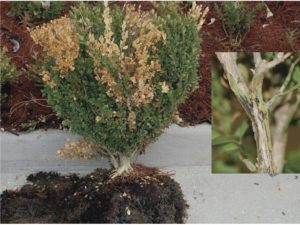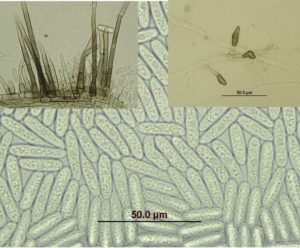Although most people are understandably concerned about boxwood blight, boxwood does suffer from a number of diseases, including Volutella blight and Macrophoma leaf spot. Unfortunately, boxwood also suffers from a stem decline, caused by Colletotrichum theobromicola. The following was written by Dr. Raj Singh, LSU.
Boxwood Stem Decline by Dr. Raj Singh Available on line at: https://www.lsu.edu/agriculture/plant/files/PPCPNewsletter_January2015.pdf and
https://apsjournals.apsnet.org/doi/10.1094/PDIS-09-14-0948-PDN
Boxwood (Buxus sp.) is an important landscape shrub in Louisiana, the south and the nation. Several cultivars are commercially available, and its vibrant green color and evergreen growth make it a popular ornamental. Boxwoods are used as stand-alone specimens at the entrances to homes and businesses. They are also grown as low, clipped hedges around homes and commercial landscapes and have become the top choice ornamental for new developments across Louisiana.
In 2011, the Plant Diagnostic Center received diseased boxwoods from commercial and private landscapes that exhibited symptoms indicative of a well-known root rot disease of boxwood caused by Phytophthora species. Symptoms include random dieback of twigs with light tan colored foliage. Affected leaves do not defoliate and tend to stay attached to the branches. Root and crowns of affected plants look normal (Figure 1).

Figure 1: Boxwood infected with boxwood decline showing light tan foliage with normal root system (inset: bright black discoloration of stem under bark).
The infection also causes a bright black discoloration of the stem immediately under the bark (Figure 1). This bright, black discoloration extends all along the infected twigs and differs from discoloration of the crown region caused by Phytophthora root rot.
Several attempts to isolate or detect Phytophthora sp. from the roots and crowns of the infected plants failed. Symptomatic tissue taken from the transition zone of healthy and
dead twigs was plated onto potato dextrose agar and resulted in consistent isolation of a Colletotrichum sp. (Figure 2.) The pathogenicity tests produced similar symptoms on artificially inoculated boxwoods after three months. After further evaluation, Colletotrichum theobromicola was confirmed as the causal agent of the boxwood decline by amplifying the internal transcribed spacer region.
Currently, boxwood decline has been confirmed from Alabama, Louisiana, North Carolina, South Carolina, and Virginia, and is suspected to be present in Indiana, Mississippi, New York and Tennessee. Because boxwood decline is a recently discovered disease, effective control measures and diagnostic tools have not yet been developed.
Due to slow disease development, it will take some time to determine which fungicides
are effective in managing decline. The timing of fungicide application also will be a crucial factor in disease management. In the meantime, landscapers, nursery producers and homeowners are recommended to follow good cultural practices and create an environment that will decrease
the spread and development of the disease. In landscapes where the disease is already present, surface disinfection of pruning and cutting tools is important to reduce the spread of the disease. Removing dead and dying twigs and avoiding unnecessary injury also is important to avoid infection.
It is too soon to determine the overall impact
of boxwood decline on boxwood industry in Louisiana and the nation. Boxwood is a specialty crop in Louisiana’s nursery and landscape industry, and a very important woody ornamental. The total value of boxwood is not known in Louisiana, but according to the 2010 USDA National Agricultural Statistics Service the wholesale market value of boxwood was estimated at $103 million annually. According to 2013 Louisiana Agriculture Summary, there are 730 nursery operations in Louisiana producing a gross farm value estimated at $155 million. While some nurseries specialize only in boxwood, most of them are involved with boxwood as wholesale traders or retailers. The disease impact also extends to landscape architects who design landscape installation and maintenance companies.
